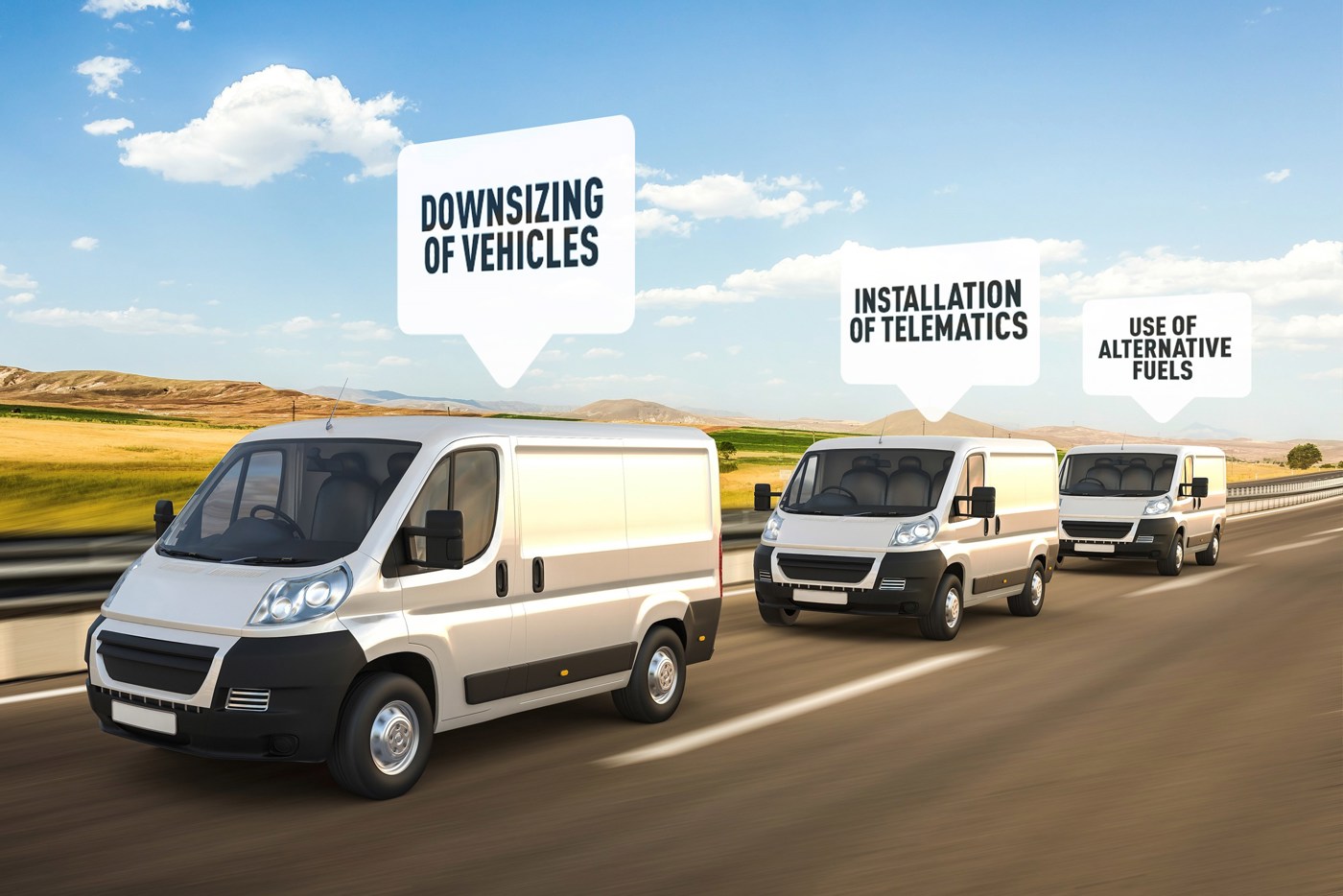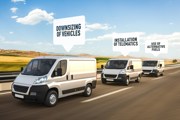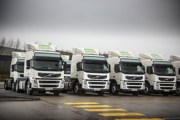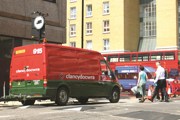Technological advances from commercial vehicle manufacturers often steal the limelight in cutting emissions and fuel bills, but fleets can take a ‘self-help’ approach to further reductions with telematics, new fuels and ‘right-sizing’ vehicles.
Most telematics systems make data available on fuel and CO2 monitoring, driver behaviour, vehicle diagnostics including maintenance alerts, location tracking and geo-fencing.
As a result, telematics is no longer being billed as a ‘nice to have’ solution for commercial vehicle fleet operators, but a ‘have to have’.
Mark Lovett, head of commercial vehicles at LeasePlan UK, says: “Driver training and telematics can help minimise the impact that commercial vehicles have on the environment.
“Avoiding harsh braking and accelerating makes a huge difference, and telematics can help fleet managers effectively target corrective driver training.”
Travis Perkins operates 4,000 commercial vehicles and introduced telematics five years ago. The benefits have included:
■ Almost 400 vehicles cut from the commercial vehicle fleet – virtually all trucks – as a consequence of improved vehicle utilisation, delivering operating cost savings of more than £50,000 per year per HGV removed.
■ A 70% daily reduction in vehicle idling – the average vehicle spent more than 100 minutes per day idling, wasting up to three litres of diesel.
■ Major fuel savings – and therefore emission savings – as a result of improved journey route planning and scheduling and employees’ adopting a smoother driving style.
Graham Bellman, Travis Perkins group fleet director, says: “The cost of the system was paid for by the fuel savings. Everything else has been a bonus and delivered savings totalling millions of pounds year-on-year to the company’s bottom line. It’s important that fleet decision-makers embrace technology.”
“Driver training and telematics can help minimise the impact that commercial vehicles have on the environment”
Mark Lovett, Leaseplan
Like Travis Perkins, O’Donovan Waste Disposal has achieved significant savings on fuel usage. As a London-based construction waste management company, it also uses telematics to reduce its environment impact.
Managing director Jacqueline O’Donovan says: “Fleets can use technology to make a massive difference to their environmental performance, which will deliver important benefits when it comes to reducing emissions.”
The company has invested £80,000 installing a telematics system across its 85-strong HGV fleet. O’Donovan says operating in London “we have to take great care when route planning and monitoring driver behaviour to reduce our impact on the environment”.
The system enables the company to monitor driver behaviour – including speeding, harsh braking or cornering, and idling – in real-time and thus identify training requirements to improve efficiency. As a result, the number of such events has dropped by 25% over 10 months, delivering time and fuel savings.
O’Donovan adds: “When working on a specific job, we pull together a site logistics plan to ensure that the safest and most effective route to and from sites is used and, where possible, consolidate deliveries and collections so fewer journeys are needed. Through this and our driver education programme, we have managed to reduce CO2 emissions by 21.5% per km travelled between 2012/13 and 2013/14, and our HGV idling by 50% since 2010.”
“On average, diesel delivery vans are only half-full driving to the centre of a city and going to the same places. We consolidate deliveries that are going to the same place”
Sam Clarke, Gnewt Cargo
Gary Banister, national account manager for Hitachi Capital Commercial Vehicle Solutions, says that fleets can use the most efficient route from a cost, time and CO2 perspective by carefully analysing journeys through the use of telematic. This not only reduces costs, but also minimises their impact on the environment.
“Telematics will also help fleets plan journeys in advance, as they are able to determine whether multiple vehicles are absolutely necessary, especially when jobs are in close proximity to each other,” Banister adds.” Precise planning of routes is especially important for large vans and HGVs, which may be restricted by the roads they can use.”
Lovett also highlights how vehicle diagnostic reports delivered via telematics systems enable fleet operators to plan maintenance schedules that correspond to real-time vehicle health status.
Freight Transport Association (FTA) figures suggest there are 1.2 million unroadworthy vans on UK roads and Lovett says: “Existing commercial vehicles’ emissions can be managed by seeking regular services. Unroadworthy vans usually record higher emissions than their well maintained counterparts.”

Mark Lovett, head of
commercial vehicles at
LeasePlan UK: 'Telematics
can help fleet managers
effectively target
corrective driver training.'
Manufacturers also deserve some credit in the area of telematics as a growing number have introduced their own systems for vans.
Citroën has offered fleets a telematics solution for years that includes satellite navigation as well as optional, Fleet Director real-time fleet management services. It says the technology has been fitted to more than 100,000 vans.
Ford and Volkswagen have recently launched telematics solutions to fleet operators that are claimed to be compatible with almost any vehicle in the market.
Kevin Rendell, head of service and parts at Volkswagen Commercial Vehicles UK, says: “Running a cost-effective fleet is crucial to maintaining a profitable business, which is why more and more companies are investing in telematics to help manage their fleets. Our telematics system can help companies reduce fuel costs, extend the life span of parts and components, and optimise vehicle efficiency.”
Ford claims its real-time telematics system, operated by Telogis, will improve fleet efficiency and cut total ownership costs for businesses. These include potential fuel cost reductions of up to 20% from optimised vehicle usage and driving routes and improved driving behaviour.
Speed limiters
Another fuel-saving tactic adopted by fleet operators is to fit speed limiters. The Low Carbon Vehicle Partnership (LowCVP) calculates that driving at 70mph uses 9% more fuel than at 60mph and driving at 80mph uses 25% more fuel than driving at 70mph.
Clancy Group, which operates 140 HGVs and 1,100 LCVs, has introduced telematics across its fleet, but has also fitted car-derived vans with speed limiters governed to 70 mph and other light commercial vehicles limited to 62 mph. It introduced speed limiters almost four years ago and saved around £300,000 in the first 12 months.
Alternative fuels
Go Ultra Low, the collaborative campaign by the motor industry and the Government to encourage businesses to operate ultra-low-emission vehicles, says commercial vehicle operators and fleet managers are missing out on a share of more than £2.6 billion in potential fuel savings.
Nearly half of the 3.7 million vans on UK roads could tap in to the typical saving of £1,459 per vehicle per year from using an electric van in place of an equivalent diesel vehicle (based on 20,000 miles a year using CAP Automotive data).
Go Ultra Low claims that millions of operators run small and medium-sized vans as back-to-base or short-haul vehicles, a duty cycle perfectly suited to pure-electric vans, such as the Nissan e-NV200 and Renault Kangoo Van Z.E., or a plug-in hybrid, such as the Mitsubishi Outlander 4Work.
Plug-in commercial vehicles do not meet all fleets’ requirements due to range and payload constraints. Gnewt Cargo – an acronym for Green New Transport – is aiming to change “last-mile logistics” globally with what is claimed to be the world’s largest single city-based fleet of pure electric vehicles.
The business uses about 100 electric vehicles to deliver parcels in central London on behalf of a wide range of organisations. However, it has plans to launch across the UK and worldwide, with a hub in Oxford due to open this summer.
Director and co-founder Sam Clarke says: “On average, diesel delivery vans are only half-full driving to the centre of a city and going to the same places. We consolidate
deliveries that are going to the same place.”
There are about 460,000 HGVs in the UK and new research by the Low Carbon Vehicle Partnership suggests diesel’s virtual complete market domination as a fuel – there are about 1,000 dual-fuel (diesel and methane) trucks over 18 tonnes GVW and 100 electric trucks under 18 tonnes GVW – will gradually fade to 20% by 2050. It anticipates methane taking a 40% share, with electric and hydrogen 20% each.
BOC, the UK’s largest supplier of industrial gases, says the trend away from diesel has already started. It is building refuelling stations and supplying liquefied natural gas (LNG) to freight and logistics companies which are already running more than 100 dual-fuel LNG vehicles.
Asda recently opened its own BOC-installed LNG station in Avonmouth to third-party fleet use. The refuelling station supports the UK supermarket chain’s fleet of 52 dual-fuel Volvo trucks and is the latest development in its transport sustainability strategy.

Sam Clarke of Gnewt
Cargo, which uses electric
vehicles and consolidates
deliveries to the same place
Dual-fuel allows natural gas to be used in conjunction with diesel, reducing the total consumption of diesel and cutting CO2 emissions. LNG typically accounts for up to 60% of total fuel consumption for a dual-fuel vehicle and when used with diesel typically reduces CO2 emissions by 10-14%.
An Asda spokesman says: “The vehicles are different from conventional diesel vehicles; drivers need to get used to new technology and have regular training to maximise performance. If you commit to training drivers and understand the differences between diesel and LNG, the implementation will result in strong benefits, both financial and environmental.”
The Low CVP’s ‘Low Emission Van Guide’ highlights how electric, plug-in hybrid, CNG/biomethane, LPG and B30 biodiesel vans all have optimum CO2 emissions better than diesel rivals, while Mercedes-Benz says its petrol-engined Citan van is particularly attractive to urban fleets due to lower NOx emissions than diesel.
Similarly, Ford will soon launch a 1.0-litre EcoBoost petrol version of its Transit Connect, delivering 50.4 mpg and CO2 emissions of 129 g/km (Transit Courier 55.4mpg and 115 g/km) as it continues the roll out of Euro 6 engine models.
Hydrogen
Finally, the future may already have arrived as BOC works with commercial fleets to promote the use of hydrogen.
It opened the UK’s first dual pressure (350 and 700 bar) hydrogen refuelling station at Honda’s Swindon plant. The facility has added an electrolyser that uses solar-generated electricity, making it the UK’s first commercial scale refuelling site producing truly ‘green’ hydrogen.
The fuel is powering the first hybrid vans, which use a mix of sustainable biodiesel and hydrogen. Eight Ford Transit-based vans are being operated by the business services company Commercial Group and a further five by Swindon Borough Council as part of a consortium.
Commercial Group has won numerous awards for reducing the environmental impact of its expanding 100-strong fleet – it has reduced its carbon footprint by more than 50%, while expanding the fleet by 80% since 2006. The vans have a range of more than 200 miles using hydrogen.
Simon Graham, environmental strategist at Commercial Group, says: “They operate as part of our LCV fleet, so we can collect real data on the limitations and advantages of hydrogen and how they meet day-to-day operational requirements. Our experience to date has been excellent.”
The company’s environmental agenda has helped it win and retain business, says Graham: “It has made the company more competitive. Customers want to save money and we are able to make ourselves competitive by being more efficient, which includes removing the cost of diesel.
“For the UK to meet its air quality and carbon targets, it is essential that we find new ways to deliver the goods and services that the economy depends on. Using hydrogen produced from sunlight to power vehicles has the potential to help solve both environmental challenges.”
Right-sizing
In the vehicle selection process, Lovett says it is critical that fleet operators “carefully consider” emissions: “Even apparently small differences on paper can make a huge difference to real-world cost and carbon output.”
Fleet operators should utilise a mix of van types to deliver the variety of duties required, which will allow low-emission models to play a role best suited to their capabilities.
“On many fleets, commercial vehicle buying habits are just that – habits. It is worth spending time looking at ‘right-sizing’ the fleet composition”
Simon Cook, GE Capital
Modern vans come in a sufficiently wide range of roof and wheel base configurations that operators may be able to downsize from 7.5-tonne trucks.
Citroën highlights the new Relay, which it says has up to 15% better fuel economy and lower CO2 emissions figures, but a payload of up to 1,995kg, with some models offering almost 400kg more than some competitors.
Fleets often replace vehicles like-with-like rather than assessing the size of vans they use and the loads they carry.
Simon Cook, GE Capital UK fleet LCV leader, says: “On many fleets, commercial vehicle buying habits are just that – habits. Larger panel vans often tend to be treated as the norm because they have formed the basis of the fleet for decades.
“However, the choice of size and shape of vans available is now enormous – from small car-derived vans, ‘cube’ and midi models through to traditional panel vans and larger vehicles that are almost classifiable as trucks.
“It is worth spending some time looking at ‘right-sizing’ the fleet composition, carefully examining needs in terms of capacity and payload. It may be the case that the core vehicle can be taken down a whole class in size, with commensurate savings in costs ranging from fuel to taxation as well as huge reductions in CO2.
“Similarly, it could be that for some applications, a larger van is a better solution than using a couple of smaller vehicles on the same routes.”
Andy Hill, commercial vehicle manager at Lex Autolease, adds: “Environmentally conscious technology is improving. Where businesses may have previously needed a bigger engine to run large vehicles, they can now use smaller, efficient engines with high power outputs, cutting down on unnecessary carbon emissions.
“Vehicles are also being chosen to fit the job role more effectively than before. For example, journeys primarily in urban environments don’t generally require a large or powerful vehicle. With more options in technology and vehicles available to companies, they are able to select a more efficient choice.”
Meanwhile, the Low Emission Van Guide advises: “The best way to reduce emissions and cost is to use smaller and lighter vehicles. Downsizing from a larger vehicle will also open doors to more low-emission van options.”
Author: John Charles




















Login to comment
Comments
No comments have been made yet.